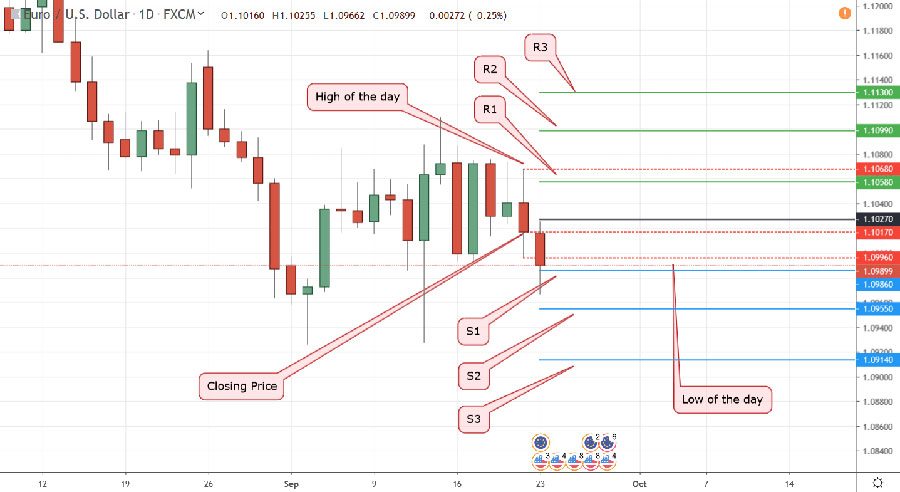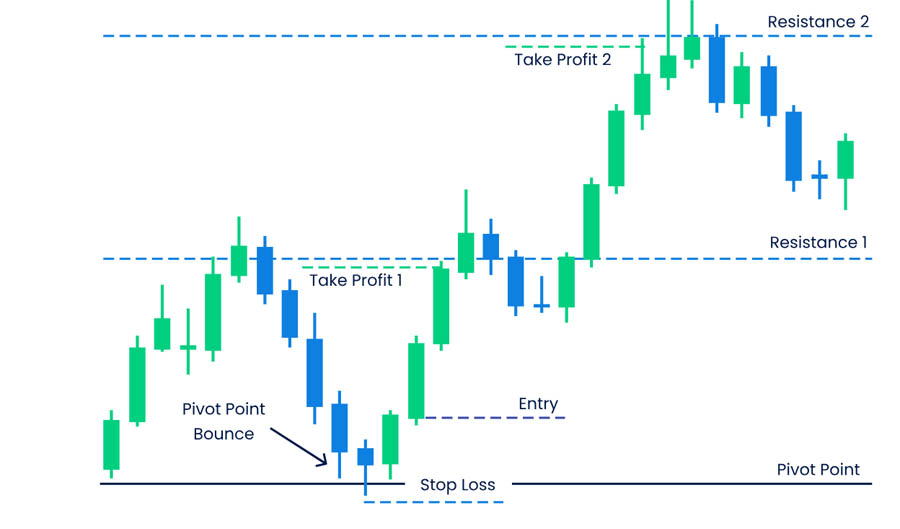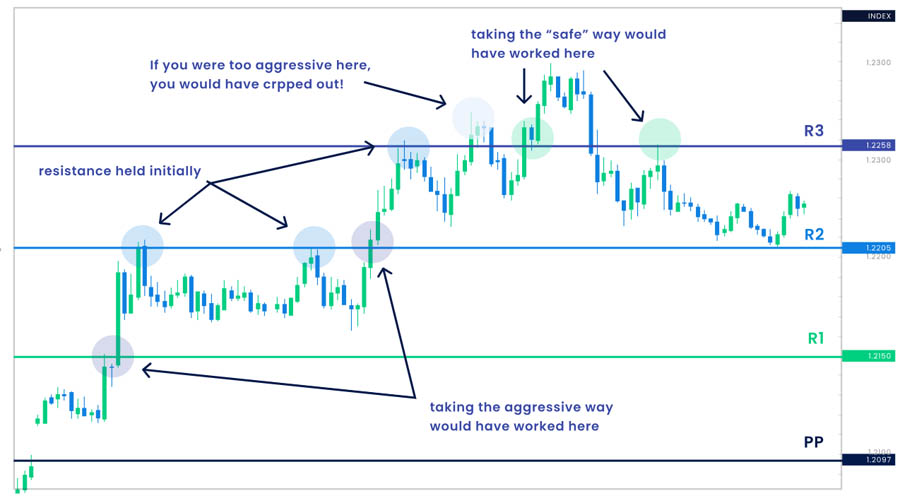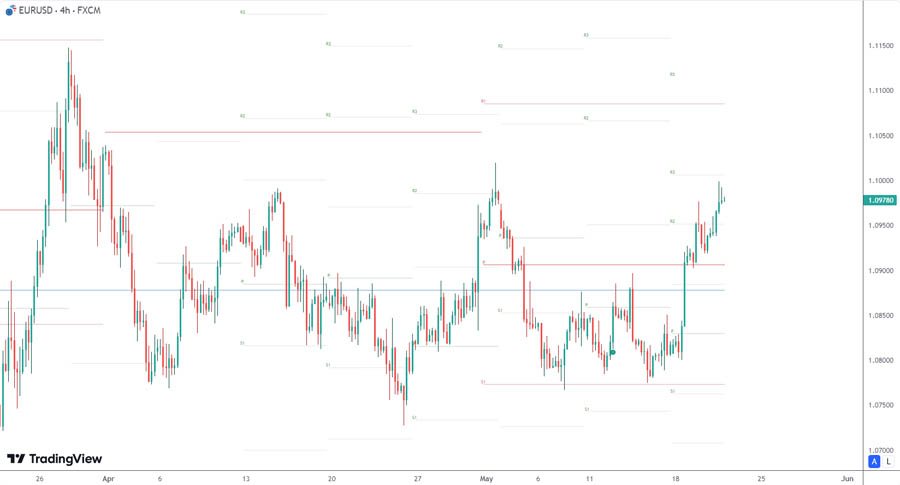A pivot point swing trading strategy is a powerful tool in the world of technical analysis, offering traders the opportunity to make informed decisions based on key price levels. Pivot points are widely used to determine potential support and resistance levels, which can guide traders in predicting market reversals or continuations. By understanding how to use pivot points in swing trading, you can significantly improve your chances of success, whether you trade stocks, work with an online forex broker, or invest in cryptocurrencies.

Pivot points provide objective levels that help traders align their decisions with market trends. These levels serve as reference points for identifying critical zones where price action could reverse, helping traders set more accurate entries and exits. This article explores seven pivotal strategies to help you implement a reliable pivot point swing trading strategy that can make a notable difference in your trading results in 2024.
Understanding Pivot Points in Swing Trading

What Are Pivot Points?
Pivot points are calculated levels derived from the previous day’s high, low, and closing prices. These key levels are essential because they create a “map” of where price action is likely to encounter support or resistance. Pivot points are particularly useful in swing trading because they provide objective levels to assess market direction and help traders plan their entries and exits.
For example, suppose you’re trading the forex market, and the previous day’s high was 1.1200, the low was 1.1000, and the closing price was 1.1100. The pivot point for the following day would be the average of these values, providing a guide for where price might pivot around during the next trading session. Pivot points offer traders the ability to see price dynamics without relying solely on indicators.
Read More: price action swing trading strategy
How to Calculate Pivot Points
Understanding how to use pivot points in swing trading starts with calculating them. The standard formula for calculating pivot points involves three primary elements: the high, low, and close from the previous trading session. Using these three data points, traders can calculate not only the pivot point but also key support and resistance levels:
- Pivot Point (PP) = (High + Low + Close) / 3
- Support 1 (S1) = (PP × 2) – High
- Support 2 (S2) = PP – (High – Low)
- Resistance 1 (R1) = (PP × 2) – Low
- Resistance 2 (R2) = PP + (High – Low)
Once these levels are established, traders can use them to gauge where price might find support or resistance. It’s crucial to recalculate these levels daily or weekly, depending on your swing trading timeframe, to ensure your strategy stays aligned with current market conditions.

The Synergy of Pivot Points and Swing Trading
Swing trading focuses on capturing price “swings” over a period ranging from several days to a few weeks. When combined with pivot points, swing traders can identify potential reversal zones, establish more accurate entry and exit points, and optimize their stop-loss placement. This synergy is especially valuable in volatile markets, where swing trading typically thrives.
Benefits of Using Pivot Points in Swing Trading
Pivot points offer several advantages when integrated into your swing trading strategy:
- Objective Price Levels: Pivot points provide mathematically defined levels, reducing the ambiguity often associated with subjective analysis.
- Easy to Implement: The calculation is straightforward, allowing both novice and experienced traders to apply them efficiently.
- Widespread Usage: Pivot points are used by many traders, which can lead to self-fulfilling prophecies where price reacts as expected at these key levels.
- Adaptability: Pivot points can be applied to various markets, including forex, stocks, commodities, and cryptocurrencies, and work across different timeframes.
Top 7 Pivot Point Swing Trading Strategies

1. The Classic Pivot Bounce Strategy
The Classic Pivot Bounce Strategy is a simple yet effective method that revolves around waiting for the price to approach a pivot point and then bouncing off it. This strategy helps traders capitalize on reversals and is particularly useful in ranging or moderately trending markets.

- Entry: Look for price to approach a pivot level and show a reversal candlestick pattern (such as a pin bar or engulfing candle).
- Stop-Loss: Set your stop just beyond the pivot point to reduce risk.
- Profit Target: Aim for the next pivot level as a logical profit target.
For instance, in a forex market scenario, let’s say EUR/USD approaches the pivot point at 1.1100. A reversal pattern at this level signals a potential bounce, allowing you to enter a buy trade. Your stop loss would be set slightly below 1.1100, and your target could be the next resistance level at 1.1150.
This strategy can be adapted to any financial instrument. If you’re trading stocks or cryptocurrencies, the concept remains the same: wait for a price reversal near the pivot point, and use the subsequent move to generate profits.
2. Pivot Point Breakout Strategy
The Pivot Point Breakout Strategy focuses on trading breakouts above or below pivot levels. Breakouts often signal the start of a new trend, and pivot points can help pinpoint entry and exit points. To confirm the validity of a breakout, volume analysis is crucial. A breakout accompanied by high volume is generally more reliable than one with low volume.

- Entry: Enter when the price breaks above or below a pivot point and retests the level.
- Stop-Loss: Set stops just beyond the broken pivot level to account for potential false breakouts.
- Profit Target: The next support or resistance level serves as a reasonable target.
In this strategy, traders need to be aware of false breakouts. Many times, price might break above a pivot level briefly and then fall back. To avoid being caught in these fake moves, it’s essential to wait for confirmation, such as a retest of the pivot level or a significant increase in volume.
Read More: 50 EMA Swing Trading Strategy
3. Multiple Time Frame Pivot Alignment
This strategy involves analyzing pivot points across various timeframes to find points of confluence, which increase the likelihood of a successful trade. If daily, 4-hour, and 1-hour pivot points all align at the same level, it could signal a highly probable reversal or continuation zone.

- Recommended Timeframes: Consider using combinations like daily, 4-hour, and 1-hour charts to strengthen your analysis.
- Entry Signal: Only enter when pivot points from multiple timeframes align at the same price level.
For example, if you notice that the daily pivot point and the 4-hour pivot point are both showing support at the same price level, it adds a layer of confluence, making it more likely that the price will react at this level. This helps reduce the risk of false signals and improves the accuracy of your trades.
4. Pivot Point Moving Average Crossover
This strategy combines moving averages with pivot points to create high-probability setups. The 50-day and 200-day exponential moving averages (EMAs) are commonly used in this method. When the moving averages cross near a pivot point, it often signals a strong trading opportunity.
- Entry: Enter when a moving average crossover happens near a pivot point.
- Stop-Loss: Place stops based on pivot levels and the slower-moving average.
- Target: Use the next pivot level or a nearby resistance/support level for your profit target.
By adding a moving average crossover to your pivot point strategy, you can better filter out false signals. Moving averages help smooth out price data, making it easier to spot true trends and reversals. If both the moving average crossover and the pivot point suggest a reversal, it strengthens your confidence in the trade.
5. RSI-Pivot Point Divergence Strategy
The RSI-Pivot Point Divergence Strategy involves using the Relative Strength Index (RSI) to identify divergence near pivot levels. Divergence occurs when the price moves in the opposite direction to the RSI, signaling a potential reversal.
- Entry: Look for divergence between price and RSI near pivot points, then enter when candlestick confirmation occurs.
- Stop-Loss: Place stops just beyond the pivot point.
- Profit Target: Aim for the next pivot level.
Divergence is one of the most reliable indicators of potential reversals. When combined with pivot points, it gives traders a strong signal to enter or exit a trade. For example, if the price is forming higher highs, but the RSI is forming lower highs near a resistance level, this could indicate a weakening uptrend and a possible reversal.
6. Fibonacci-Pivot Point Combination
Fibonacci retracement levels, combined with pivot points, can provide additional layers of confluence for entry and exit points. This strategy is particularly useful for identifying zones where price might reverse or continue a trend.
- Confluence Zones: Look for areas where pivot points and Fibonacci retracement levels overlap, offering stronger potential for a reversal.
- Entry: Enter trades when price reaches these confluence zones.
- Profit Target: Use Fibonacci extension levels to set extended profit targets.
In this strategy, Fibonacci levels can act as potential entry points, while pivot points provide the structure to manage trades. When these levels align, it creates a higher probability of a successful trade. It also helps traders identify both entry and exit points, which is crucial for swing trading.
7. Time-Based Pivot Point Strategy
The Time-Based Pivot Point Strategy involves calculating pivot points based on specific timeframes and trading only during high-liquidity periods. High volatility times, such as the London-New York overlap, provide better opportunities for pivot point strategies.
- Best Times to Trade: Consider trading during market openings and major sessions for increased volatility.
- Entry: Enter trades when pivot points align with key session openings.
- Target: Use session-based resistance and support levels for setting your profit targets.
This strategy is especially useful for forex traders, as volatility spikes during certain trading sessions. By aligning pivot points with these periods, traders can take advantage of significant market movements.
Risk Management and Best Practices for Pivot Point Swing Trading

Effective risk management is essential for maintaining profitability in swing trading. Pivot point swing trading strategies yield the best results when combined with disciplined risk management techniques. Here are the key practices to consider:
1. Use Stop-Loss Orders
- Strategic Placement: Always set your stop-loss orders slightly beyond pivot levels. This helps protect against minor price fluctuations that can occur in volatile markets.
- Capital Protection: By placing stop-loss orders strategically, you can safeguard your capital while allowing for normal price action.
2. Position Sizing
- Appropriate Sizing: Ensure your position size aligns with your account size and risk tolerance. A common guideline is to risk no more than 1-2% of your trading capital on a single trade.
- Risk Mitigation: This conservative approach helps mitigate losses and preserves your trading capital over the long term. Consider using a position sizing calculator to determine the optimal trade size based on your risk parameters.
3. Maintain Discipline
- Adhere to Your Strategy: Stick to your trading plan and avoid letting emotions dictate your decisions.
- Trust the Levels: Pivot points provide objective guidance; trust these levels and follow your trading plan consistently.
- Reflect on Your Trades: Keeping a trading journal to track your trades and reflect on your decision-making can reinforce discipline and help you learn from both successes and failures.
By incorporating these risk management techniques and best practices into your trading routine, you can enhance the effectiveness of your pivot point swing trading strategies and improve your overall trading performance.
Advanced Pivot Point Concepts: Enhancing Your Swing Trading

For swing traders looking to refine their pivot point swing trading strategy, advanced concepts like Camarilla Pivot Points and Woodie’s Pivot Points offer greater precision and adaptability. These variations provide detailed support and resistance levels, helping traders better time their entries and exits.
Camarilla Pivot Points: Precision for Short-Term Reversals
Camarilla pivot points are calculated using tighter levels, making them ideal for spotting short-term reversals.
- More detailed support and resistance levels: Eight key levels (four support, four resistance) offer more precise trading zones.
- Popular with day traders: Tighter levels allow for quicker decision-making.
- Swing trading benefit: Great for short-term reversals and tighter stop-losses.
How to Use in Swing Trading:
- Entry: Buy/sell near Camarilla pivot reversals.
- Stop-loss: Set just beyond the pivot.
- Profit target: Use the next pivot level.
Woodie’s Pivot Points: A Unique Calculation
Woodie’s pivot points weigh the opening price more heavily, making them suitable for certain volatile markets.
- Alternative calculation: Focuses on the open price for recent trends.
- Great for certain markets: Forex and commodities traders benefit from its unique perspective.
How to Use in Swing Trading:
- Entry: Trade near Woodie’s support/resistance levels.
- Stop-loss: Place around the nearest pivot.
- Profit target: Set at the next pivot level.
Opofinance: A Trusted Broker for Pivot Point Swing Trading Strategies
When implementing pivot point swing trading strategies, choosing a reliable broker is crucial to your success. Opofinance stands out as a trusted platform for both beginners and seasoned traders, offering a comprehensive suite of tools and services tailored to enhance your trading experience.

Here’s why Opofinance is an excellent choice for traders looking to master how to use pivot points in swing trading:
- ASIC Regulation: Opofinance is fully regulated by ASIC, ensuring a secure and transparent trading environment. This regulatory oversight provides peace of mind for traders who prioritize safety and compliance.
- MT5 Platform: Opofinance offers access to the MetaTrader 5 (MT5) platform, known for its advanced charting tools and technical indicators like pivot points. The platform’s versatility makes it easier for traders to apply pivot point swing trading strategies effectively.
- Social Trading: For traders looking to learn from experts, Opofinance’s social trading feature allows you to follow and copy successful pivot point traders, accelerating your learning curve.
- Fast Execution and Tight Spreads: Timing is critical in swing trading, and Opofinance’s fast order execution and competitive spreads help ensure that you can enter and exit trades at optimal levels without significant slippage.
- Secure Deposits and Withdrawals: Opofinance offers multiple secure deposit and withdrawal methods, ensuring your funds are handled safely while you focus on refining your trading strategies.
By choosing Opofinance, traders can confidently apply pivot point swing trading strategies with the support of a reliable, feature-rich broker, making it easier to navigate market fluctuations and maximize trading opportunities.
Conclusion
Pivot point swing trading strategies offer a clear and objective approach to navigating the markets, enabling traders to capitalize on key price levels while reducing risk. These strategies encompass various methods, from breakout strategies to time-based trading, highlighting the versatility of pivot points as an invaluable tool for swing traders in 2024.
By integrating pivot points with other technical indicators, such as RSI, moving averages, or Fibonacci retracements, you can further refine your trading strategy and enhance your overall success rate. This combination allows for more precise entry and exit points, helping you identify high-probability trading opportunities.
Implementing these seven proven strategies, alongside sound risk management techniques, can significantly transform your trading results. If you aim to optimize your trading performance, understanding how to effectively use pivot points in swing trading is essential for achieving long-term profitability. Equip yourself with the knowledge and tools to succeed, and watch your trading game reach new heights.







